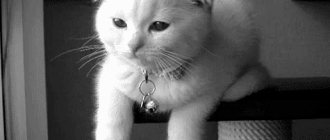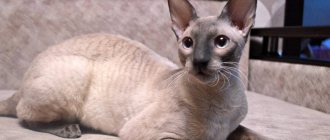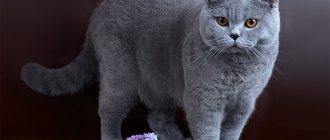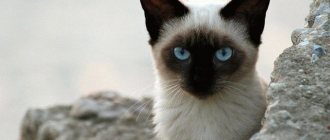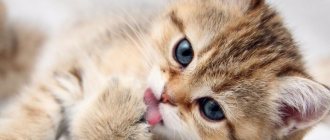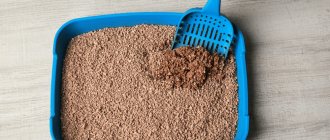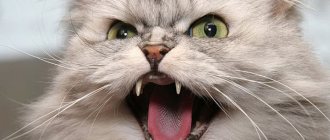It is still unknown exactly when cats (Félis silvéstris cátus) began to live next to humans. Scientists talk about more than ten thousand years of successful partnership between people and perfect predators - hunters of mouse-like rodents - cats. The partnership between humans and the ancestors of the modern cat began with the transition of people to sedentary life, the emergence of food storage and the need to protect them from mice and rats. For cats, the high concentration of rodent pests in human settlements, on the contrary, was very beneficial, since cats could hunt in a small area with a high degree of efficiency - at the same time bringing benefits to people, and therefore without causing aggression towards themselves. Gradually, the cat became one of the most important pets, and today it shares first place in popularity with the dog.
Over the long period of domestication, the wild nature of cats has remained almost unchanged. The physiology, anatomy and psychology of cats are still very similar to their ancestors - one of the most effective predators in the world. To create a comfortable living environment for your cat in your home, while simultaneously taking care of the health and well-being of the animal, it is important to know some rules. We will talk about them in this article.
How to prepare your home for a cat?
It should be remembered that before bringing a kitten or an adult cat home, you will need to make certain preparations:
- domestic cats are curious, so it is necessary to remove all toxic substances and sharp objects (pins, needles, nails, etc.);
- Open windows unprotected by nets pose a great danger to cats - falling from windows in the summer, unfortunately, is quite common. Hinged windows also pose a potential danger - a pet can get stuck in them and receive a compressed chest injury;
- You probably won't be able to change your cat's habit of living in three dimensions. Therefore, simply remove fragile objects that the cat can easily drop (accidentally or on purpose), and provide the pet with some freedom of movement;
- Be sure to buy your cat a house - a place where she would feel absolutely safe. This is especially important if there are other animals at home that can disturb the cat while sleeping;
- you also need to buy a special scratching post; we recommend purchasing several pieces and placing them in convenient places for the animal;
- the cat should have a place for the toilet, located separately from places where it eats and drinks;
- A cat at home needs free access to drinking water. It is better that your pet has several sources of drinking water (2-3), and they should be placed so that food cannot get there. Pay attention to specialized fountains and high-quality drinking bowls. It is better if the drinker is ceramic or metal, not too small. Fresh water should be available to the pet 24 hours a day. We recommend using bottled water and replacing it regularly, regardless of whether your pet has drunk all the water or not;
- Finally, it is advisable to purchase special toys for your cat. It is better to buy them in specialized stores.
SMALL ANIMAL CLINICAL NUTRITION
INTRODUCTION
To maintain good health, cats must have appropriate feeding and care.
Proper feeding of cats requires knowledge of their nutritional needs depending on their life stage and physiological state. Specific differences in feeding cats compared to dogs are due to behavioral, anatomical, physiological and metabolic characteristics.
According to the taxonomic classification, cats and dogs belong to the order of carnivores. Cats, as you would expect, show all the signs of predators in terms of feeding and behavioral characteristics. Dogs, by the nature of their diet in natural conditions, can be largely classified as omnivores. This fact is clearly confirmed by the fact that, for example, coyotes in Southern California feed on melons, apricots, grapes, plums and cherries. Wild relatives of dogs eat their prey whole. And since their prey in nature is mainly herbivores, by eating their gastrointestinal tract, they receive a certain amount of plant food. Domestic dogs sometimes willingly eat the feces of herbivores. Cats don't usually eat the insides of their prey.
The fact that cats are strictly carnivorous animals is confirmed by the anatomical features of the structure of their teeth, jaws, muzzle and limbs. Cats have fewer molars and molars than dogs, and their canines are better suited for tearing food. Cat jaws have limited lateromedial and craniocaudal mobility. This limits the ability to chew food and makes it easier to tear animal tissue. The characteristics of the dental system and the greater mobility of the jaws in dogs are an indicator of the possibility of using a more varied diet for their nutrition, including plant foods.
Cats' eyes are excellent for hunting. They are located on the front of the muzzle and are very sensitive to various movements. Cats' ears are vertical and point forward.
Cats have specialized tactile hairs on their faces. They help cats hunt at night and protect their eyes.
Cats' paws are equipped with retractable claws, adapted for better hunting. Dogs' claws play only a supporting role in holding prey.
Cats are also characterized by certain physiological and metabolic characteristics.
1. Energy metabolism. It is interesting to note that the energy metabolism of cats is somewhat similar to that of ruminants.
For example:
a) In the liver of most animals there are two active enzyme systems: hexokinase and glucokinase, which regulate the conversion of glucose into glucose-6-phosphate.
The glucokinase system only acts when large amounts of glucose enter the liver. Typically, the diet of cats and ruminants is low in soluble carbohydrates. Consequently, their liver has very low glucokinase activity. High glucokinase activity was detected in the liver of dogs.
b) Cats and ruminants usually consume soluble carbohydrates (lactose) only during the nursing period. In these animals in adulthood, in order to maintain a certain level of glucose in the blood, during the process of gluconeogenesis, glucose is synthesized from amino acids, propionic and lactic acids, as well as from glycerol.
In dogs, high activity of gluconeogenesis is observed only after eating, when the final absorption of nutrients in the intestinal tract occurs. And in cats and ruminants, activation of gluconeogenesis occurs already during feeding. In ruminants, the process of gluconeogenesis mainly uses propionic acid, and in cats, amino acids.
2. Protein metabolism. The main difference between cats is their increased need for protein compared to dogs. During the growth period, cats require 50% more protein than dogs. As adults, their protein needs are 2 times higher compared to dogs. The higher protein requirement of cats is not due to increased requirements for certain amino acids, but is due to the high activity of enzymes in their liver (transaminases and deaminases) that convert amino acids into keto acids, used for energy needs or for the synthesis of glucose. Unlike dogs, in cats the activity of these enzymes in the liver does not decrease with a low protein intake from food. Therefore, these liver enzyme systems in cats are always active and part of the protein consumed in food is used for energy purposes.
In addition, it has been established that in addition to gluconeogenesis, glucose can be synthesized in cats in another way, in which the amino acid serine is used as a glucose precursor.
Cats also have specific requirements for two amino acids: arginine and taurine. Arginine deficiency in cats can lead to very unpleasant consequences. Feeding cats an arginine-free diet rapidly increases plasma ammonia concentrations. In this case, as a result of acute toxicosis, animals die within 3-5 hours. The reason cats are hypersensitive to arginine deficiency is their inability to synthesize sufficient quantities of ornithine and citrulline, from which arginine is synthesized, which is necessary for the normal functioning of the urea cycle. If there is a lack of arginine in the body of cats, ammonia cannot be converted into urea and ammonia toxicosis develops. Due to the fact that the usual diet of cats contains a lot of animal tissue, with a fairly high protein content (including arginine), arginine deficiency is very rare in them.
Another amino acid, taurine or aminosulfonic acid, must be included in their diet, since cats, unlike dogs, cannot synthesize a sufficient amount of taurine from cystine. Chronic taurine deficiency can cause retinal degeneration and blindness in cats. Plant foods contain very little taurine.
3. Fat metabolism. Cats have the ability to consume and assimilate large amounts of fat, which is rich in animal tissue. Unlike dogs, they are not capable of synthesizing arachidonic acid from linoleic acid and therefore require arachidonic acid in their food. Animal fats contain large amounts of arachidonic acid.
Not only cats have a limited ability to synthesize arachidonic acid. Lions and predatory fish also have similar metabolic features.
4. Vitamin metabolism also has certain differences compared to dogs:
a) Cats do not have the ability to convert tryptophan into niacin. Therefore, the need for nicotinic acid or niacin is 4 times higher in cats than in dogs. Animal tissues are rich in niacin.
b) The prosthetic group of all transaminases is pyridoxine (vitamin B6).
Carnivores that eat raw meat, including cats, use proteins as an energy source. Consequently, their transaminase activity is very high, which explains their greater need for pyridoxine compared to omnivores. Cats need 4 times more pyridoxine than dogs.
c) Vitamin A is found only in tissues of animal origin.
The precursor to vitamin A (carotene) is synthesized by plants. Omnivores and herbivores can transform carotene into vitamin A. But cats do not have this ability.
The water needs of cats and dogs also differ, which is due to evolutionary adaptation to environmental conditions. Modern domestic cats (Felis domesticus) are descended from the African wildcat (Felis lybica), small animals that lived in the desert regions of North Africa. As descendants of these animals, domestic cats have retained the ability to concentrate urine more, which allows them to survive in conditions of insufficient water supply. But it is precisely this adaptive ability that predisposes cats to greater susceptibility to urolithiasis. A weakened sense of thirst in cats leads to such a low water intake that the amount is insufficient to prevent the crystallization of struvite (ammonium magnesium phosphate) crystals in the urine.
When using ready-made dry food, cats usually consume 1.5-2 ml of water per 1 g of dry food. This proportion (2:1) corresponds to the water content (67%) in the tissues of animals that predatory animals mainly feed on. Canned food contains about 75% water, so cats drink very little water when fed canned food.
Cats drink during the day and at night, while dogs usually drink during the day. Regardless of the type of food used, water should be constantly available to cats. Some cats drink fresh water, others prefer to let it sit for several days. Increasing water intake increases its excretion in the urine and, thereby, reduces the risk of developing urolithiasis.
FEEDING METHODS
There are several ways to feed cats:
1) Feeding with free access to feed.
2) Time-limited feeding.
3) Feeding limited in the amount of food.
With free feeding, feed is available to animals at any time. In time-restricted feeding, animals are given more food than they need for a specified period of time (usually 5-30 minutes). In this case, cats are fed at certain intervals, usually 1-2 times a day.
With restricted feeding, cats are given less food than the animal could eat. But the feeding process is not limited in time. The cats are fed 1-2 times a day.
Some owners use one of the feeding methods, others combine them.
A combination is often used: free feeding with dry or semi-dry food and limited feeding with canned food or other products (meat, table scraps, etc.).
Each method has its own advantages and disadvantages.
With free feeding, labor costs are minimal. If there are no problems with obesity, then free feeding of dry and semi-dry food is the simplest and most convenient way.
Cats, as a rule, are not gluttonous and, if food is constantly available, they eat many times during the day (10-20 times).
In summer, during the daytime, feed intake can be reduced by 50%.
When feeding several cats at the same time, each animal should have a separate bowl. If a dog is present, the bowl should be placed in such a way that the dog cannot reach it.
Many cats, especially females, have an erratic appetite. They may consume very little food for a few days and then eat large amounts of food in subsequent days. If this period coincides with a change in the usual diet, then the wrong conclusion may be made about poor eating of the new food. However, this form of eating behavior is typical for cats when using new foods.
Most healthy, non-lactating cats, when using good quality food, can meet their nutritional needs with a single feeding. However, if there are no problems with obesity, it is better to use free-feeding cats.
Free feeding or feeding at least 3 times a day, recommended for use during periods of growth, pregnancy and lactation. Due to the limited volume of the gastrointestinal tract, with a single feeding, or when using low-calorie feeds, animals during this period may not receive the amount of food they need. Excess calories during lactation and growth are not harmful to cats.
Frequent feeding of high-quality feed is preferable in diseases of the small intestine, liver, exocrine pancreatic insufficiency, in case of malnutrition, anorexia or increased feed requirements.
It is better to feed cats regularly at certain times and avoid using table scraps for feeding. These wastes, along with all sorts of additives, can unbalance your diet. It is best to feed cats special ready-made industrial food: dry, semi-dry or canned.
Special high-quality complete feeds include compatible ingredients and provide the animal with all the necessary substances. Any additives should not account for more than 25% of the diet weight.
Many cat foods that consist primarily of one product can lead to a preference for that food and a rejection of other foods.
Cats' pickiness about food is a consequence of improper feeding and is not a hereditary characteristic. Therefore, a variety of complete foods should be used to prevent the development of a stable preference for certain foods.
FEEDING STANDARDS
The amount of food required for cats can be determined by knowing the energy requirements of the animals and the calorie content of the food.
The fatness of cats is considered optimal if the ribs are not visible and there are no pronounced deposits of subcutaneous fat. Typically in cats, excess fat is noticeable as an “apron” along the surface of the abdomen. Adult cats should be weighed weekly while feeding requirements are being determined. When using conventional feed, animals are weighed monthly.
Changes of 5-10% compared to the optimal weight require adjustment in the amount of feed consumed.
Most cats independently control the amount of energy they need and eat a certain amount of food. If there are no problems with obesity, then there is no need to limit the amount of food consumed by cats.
Adult cats, with the exception of the reproductive period, if they do not show signs of obesity, can be fed high-quality dry, semi-dry or canned maintenance foods.
When feeding limited in the amount of food, animals must be fed at least twice a day. If you are obese, you should use special foods high in fiber and low in calories. The feed must contain less than 10% fat and more than 15% fiber in dry matter.
The appearance of tartar depends on the individual characteristics of cats. To reduce the intensity of tartar formation, it is recommended to use dry food and brush your animals’ teeth.
If a cat shows signs of urological syndrome, then it is necessary to ensure that the magnesium content in the food does not exceed 20 mg per 100 kcal of metabolic energy, and the urine pH should not exceed 6.4.
Proper feeding must be combined with regular grooming, especially when keeping long-haired cats. This prevents the appearance of lumps of matted hair in the digestive tract, causing disruption of the passage of food masses and vomiting.
Most cats do not need to be bathed, as this washes away their natural protective oils. If necessary, you can apply cleansing preparations to the coat, and then carefully remove them by combing.
If cats are still bathed, this should be done in a heated room, using warm water and a special mild shampoo.
Cats need a place to sharpen their claws. Cats should be active every day. Timely vaccination and antiparasitic treatments are important.
FEEDING DURING PREGNANCY
Animals should be prepared in advance for the upcoming pregnancy and given all necessary vaccinations to prevent infectious diseases in the female and her offspring. It is also necessary to carry out appropriate treatments against helminths and fleas.
During the breeding season, the female's body weight should be optimal for an adult. A complete maintenance diet should be used to feed cats during this period.
It is advisable to skip the first heat, since early pregnancy negatively affects the further growth of cats.
The duration of pregnancy in cats is 63-65 days (9 weeks), and in some individuals it can range from 58 to 70 days.
Fetuses in a cat's uterus can usually be felt from the 3rd-4th week of pregnancy. Special feeds intended for the reproductive period (for growing and lactating animals) can be used to feed females throughout pregnancy. But it is especially important to use them in the last 3-4 weeks of pregnancy. The need for nutrients during pregnancy increases and in order to avoid depleting the body's reserves, the feeding rate should be gradually increased by about 25%. Excessive weight gain in cats during pregnancy is usually due to additional fat deposition. In cats, unlike dogs, body weight after birth does not immediately decrease to pre-pregnancy levels. Cats need fat reserves to cover energy costs during lactation. Without fat reserves, as well as in the absence of high-quality food, a cat cannot provide kittens with enough milk.
During the last week of pregnancy, most cats become restless.
At this time, the cat should be placed in a box where it will be with the offspring so that the animal gradually gets used to this place. The box may be cardboard. It should be large enough for the cat to stretch out and stand up freely. The entrance should be raised by 8-12 cm so that the female can freely enter and exit, and the kittens do not fall out of the box. The lid of the box should be easy to open and close to provide twilight when necessary. The bottom of the box should be covered with a mat. The box is placed in a quiet, warm and clean place.
CARE DURING CHILDREN
Typically, birth in cats occurs without difficulty. Between contractions, the cat can get up, leave the nest and drink. The help of a veterinarian is necessary if contractions last more than two hours without result.
Usually it takes 2-3 hours to give birth to, for example, four kittens. The afterbirth is separated simultaneously with the fetus. The cat breaks the membranes and eats them. She carefully licks the kittens and clears their respiratory tract of mucus. Outside interference can disrupt the birth process. Some cats may even eat the litter if there are a lot of people in the room or if the kittens are handled and examined.
The person present during the birth must ensure that the placenta is removed after the birth of each kitten. Retention of the placenta causes infection and toxicosis, and can lead to the death of the animal. Dark red or red-brown discharge indicates complete separation of the placenta. Blood that is bright scarlet in color indicates possible bleeding. Discharge of a different color (brown, greenish), usually appearing 48-72 hours after the end of labor, is a sign of incomplete separation of the placenta, or the presence of a dead fetus in the uterus.
CARE OF NEWBORN KITTENS
Kittens should receive a sufficient amount of colostrum soon after birth, as this provides colostral immunity and protection against infectious diseases. Timely intake of colostrum is necessary to maintain normal blood circulation and water and electrolyte balance in newborns.
Fading kitten syndrome is usually due to infectious or non-infectious causes. Consuming sufficient amounts of colostrum will prevent the occurrence of this syndrome. It is recommended that newborn kittens be brought to the cat's nipple soon after they are born.
Thorough cleaning of the premises is important for the prevention of infectious diseases. Contact of kittens with other animals can only be allowed a week after the first vaccination.
A few days after birth, kittens can be held in your hands for a few minutes. This has a beneficial effect on their physiological and psychological development. They should not be disturbed while eating and sleeping.
Kittens' eyes open on the 10-16th day, and their hearing organs begin to function from 15-17 days of age. In the first 2 weeks of life, normal body temperature is about 35°C. The shivering reflex is absent in the first 6 days, so animals depend on an external heat source (the mother) to maintain the required body temperature.
At 6 days of age, kittens develop the ability to tremble, which allows them to regulate heat production to maintain a constant body temperature.
The body temperature of kittens in the period from 2 to 4 weeks increases to 36-37 ° C. After 4 weeks, body temperature reaches levels characteristic of adult animals.
At 2-3 weeks of age, kittens begin to move, which stimulates metabolism and heat production. In the first weeks after birth, kittens and the cat should be kept at an ambient temperature of at least 21°C. If kittens are separated from the cat, then special conditions must be created for them, as for orphaned animals.
Newborn kittens have very small reserves of subcutaneous fat. For energy expenditure, glycogen is mainly used, which is quickly consumed and is not replenished in the first days of life. With poor feeding, kittens quickly develop dehydration, coldness and weakness, which poses a threat to life. To prevent the death of newborn kittens, they should be kept in warm conditions, weighed daily and additionally fed if growth retardation is noted.
Kittens are weighed at birth and then weighed daily until they are two weeks old. After this, the kittens are weighed once every three days until they reach one month of age. Older animals are also weighed periodically.
Normal growth energy and formed regular stools indicate adequate feeding and good health.
Kittens weigh on average 90-110 g at birth and should gain 50-100 g weekly until they are 5-6 months old. Growth energy decreases with age and the body weight of kittens reaches values typical for adult animals of this breed by 10-14 months.
Significant individual differences are noted between kittens: the larger the parents were, the higher the growth energy of the kittens. Males grow faster and weigh more than females.
FEEDING LACTATING CATS AND
How to care for a cat at home?
Caring for a cat at home is usually not very difficult, here are some basic tips:
- vaccination. Should be done annually, even if your cat never leaves the house;
- treatment for fleas and ticks, as well as helminths - at least twice a year, despite the fact that the cat does not go outside, it can become infected with endo- and ectoparasites carried from the street on shoes or clothes, and such procedures will definitely not be unnecessary . Remember that all drugs that you will use against worms, ticks and fleas must be discussed with your veterinarian;
- Whether you should neuter your pet or not is up to you to decide. At the moment, the castration procedure is carried out effectively and safely in a veterinary clinic or even at home. The only thing you need to know is that the procedure involves anesthesia, and although the risk is minimal, you still need to do all the necessary tests.
What to do if you have allergies
It is not necessary to give up your pet unless the allergies are too severe.
- Keep your cat out of your bedroom and buy hypoallergenic bedding.
- Buy an air purifier with quality filters.
- Use an anti-allergen indoor spray.
- Avoid carpets, heavy curtains and furniture with fabric upholstery.
- Clean your home often. It’s even better if someone else does the cleaning so that you don’t inhale dust that contains allergens.
- Consult your doctor about appropriate medications.
Skin and coat care
Short-haired cats are the least demanding when it comes to grooming and maintain almost all the hygiene of their skin and coat themselves. The coat of semi-longhaired and longhaired cats requires maximum care. It consists of regular (preferably daily) combing of the coat and combing out dead hairs. Movements should be soft and smooth so as not to cause discomfort to the animal.
If your cat has tangles, you can try to untangle them with your fingers. If it doesn’t work out, then it’s best to use a special tool – a tangle cutter. By carefully combing the wool with its metal plates, you can successfully deal with even neglected tangles.
Grooming your cat is a task for a professional groomer, especially if you want to give the animal some kind of hairstyle, and we are not talking about just a hygienic haircut, as, for example, in the summer. Long-haired and semi-long-haired cats are usually cut using special professional animal clippers. If you decide to cut your cat’s hair yourself, a lot will depend on the character and upbringing of the pet. Grooming some cats at home is almost impossible or dangerous for both the owner and the animal. And although there are animals that are calm about this procedure, you will in any case need an assistant who will hold the cat and a specialized clipper.
Some cats are terrified of clippers; such animals should only be cut at a veterinary clinic or grooming salon.
Haircut tips:
- using a machine, remove hair from the sides, back and belly of the pet. With great care and a secure hold, the cat's belly and perineum are trimmed;
- trim the fur in the armpit area. Afterwards, the croup and torso are cut from behind;
- the tail is either not cut at all, or a “tassel” is left at the end;
- carefully trim the hair on the paws;
- The head is cut last, usually simply shaped with safe scissors, rounded at the ends.
Difficulties of maintenance
Pets love to sharpen their nails and often damage furniture if they want to sharpen their nails.
To avoid damage, invest in a nail sharpener.
Leave marks
To eliminate the unpleasant smell of marks, go up to your pet, grab him by the withers and growl at him, if he starts waving his paws, lightly spank him to show him who is boss in the family.
Then spray the marker with alcohol to show that the area belongs to you.
Don't go to the litter box
Your cat may refuse to go to the litter box if she feels uncomfortable or doesn't like the litter.
Adviсe:
- Rearrange the toilet until you feel comfortable;
- Find the right size for your cat;
- Keep the toilet clean at all times.
By following these simple rules, you can train your pet to use the toilet.
Domestic cats also often undergo nail trimming.
It is necessary to accustom your pet to trimming its claws from a young age, gradually introducing it to this procedure, at first only by touching its claws during communication, then gradually adding a nail clipper or blister. If your animal has not been accustomed to the procedure of trimming its claws since childhood, then trimming its claws will be quite difficult, and almost impossible for one person, without putting the pet into a stressful state and without injuring the pet. In this case, the best solution would be to contact a veterinary clinic or grooming salon.
If you do do this yourself, make sure the cat is in a supportive mood, pet it, then gently restrain the animal with the help of an assistant and, pressing on the pad of the paw, expose the claws. Using special safety pliers or blisters (available in pet stores), trim the claws. Do not cut too short; you must leave a few millimeters to the “living” claw. Do not use blunt instruments or regular nail scissors. At the end of circumcision, the claw is processed with a nail file at the cut site.
Toilet.
If a cat misses the toilet in the first days, you need to soak a piece of napkin in its urine, put it in a pot, put the cat there and let it smell. YOU CAN ' T POKE A CAT'S NOSE INTO A PUDDLE, it will be perceived as “oh, are you focusing my attention on this?!” So this is where I will continue to do my business.” The site of unauthorized peeing must be thoroughly washed. The cat needs to be trained to use a toilet with good litter. Only the poop is removed from the tray with a special scoop and thrown into the toilet or trash can (preferably in a bucket, the litter can clog the drain). Everything else is replaced centrally as the tray is closed.
Taking care of your cat's ears, eyes, and mouth is a must.
It is recommended to wipe the area around the eyes with a special product or a cotton swab dipped in a small amount of clean water. If there is profuse discharge from the eyes, the cat squints heavily, there is inflammation, or the cat rubs the eyes vigorously, this is a reason to take the animal to the veterinarian.
The cat's ears are wiped with special wipes or slightly damp cotton swabs; it is best to buy a special liquid for cleaning the ears. You should not use ear sticks, or even less make them yourself from available means - careless movement can injure the animal.
Brushing your teeth is an important point. According to statistics, more than 60% of cats suffer from dental and gum diseases to some extent, but only 10% of owners regularly brush their pets’ teeth. It is recommended to clean with special brushes or a regular toothbrush with soft bristles. You should also use a specialized paste; Your cat needs to brush its teeth 1-2 times a week.
It is important to start getting your cat used to brushing its teeth from a very early age, first by simply touching the cat's teeth with your fingers and teaching her not to bite, then gradually moving on to brushing and always using some kind of treat (for example, wet food) for reward.
Special foods have also been developed to clean teeth, for example, Purina® PRO PLAN® Cat Dental Plus®, with a special granule texture and substances that reduce the formation of tartar.
How, when and what to feed your cat?
This is perhaps one of the most common questions that a veterinarian has to answer every day. The nutrition of domestic cats should be structured according to the same rules as for cats walking on the street, but taking into account certain needs that are typical for keeping them at home.
The diet should contain:
- all necessary vitamins and minerals in the correct concentrations;
- easily digestible and complete proteins with sufficient energy value;
- fiber and prebiotics to help owners combat the common problems of litter box odor and hair regurgitation.
All these characteristics are optimally matched by Purina® PRO PLAN® Adult cat diets - balanced nutrition in dry and wet formats, made according to a special recipe developed taking into account all the needs of cats living at home. The Purina® PRO PLAN® Adult line contains the prebiotic inulin, which helps fight litter box odors and normalize the balance of your cat's intestinal microflora.
The animal must be provided with constant access to food - dry food in this case is most convenient, because it can be left freely available for a day or more.
Laws governing pet ownership
Any owner who gets a pet is immediately responsible for it; if his pet causes harm to someone or disturbs the peace, then under federal law the owner is required to pay a fine.
Responsibility for breaking laws
Each owner is responsible for his animal and its maintenance, so before purchasing it is important to make sure that all veterinary and sanitary conditions are met.
Before you buy an animal, ask your neighbors for permission or at least warn them about it.
Do not store them in public places such as stairwells or attics, and do not transport them for long periods of time on public transport.
The owner is solely responsible for damage to neighbors' property or excessive noise caused by his dog.
Owners must not:
- throw their animals into the street;
- euthanize their animals for no reason;
- have a large number of pets in the apartment.
Sanitary standards
Just like humans, cats also need to maintain good hygiene to ensure good nutrition, health and adequate living space.
- The home should have enough space for both residents and pets.
- Should not be kept in a dormitory, only in apartment-type shelters.
- Must be registered and receive an identification number.
- Vaccination should be carried out regularly.
- Provide the animal with water and food daily.
- The animal should be visited regularly by a veterinarian.
How to carry out treatment at home?
Treating your cat at home is not a simple matter and requires detailed discussion. On the one hand, the diagnosis of most diseases, and even more so their adequate treatment, necessarily requires the participation of a veterinarian. On the other hand, timely assistance to your cat in case of accidents, as well as mandatory attention to the first manifestations of any diseases in cats, is the main concern of the owner.
So here are some useful tips.
Pay close attention to your cat's overall health. Only indirect signs can indicate that a cat is sick, for example: a change in body temperature (normally from 38 to 39 C), decreased appetite, apathy, and decreased social activity.
Burns
Try to calm your pet and carefully examine the burn area. Treat the affected area of skin with dexpanthenol spray and try to bandage it. Do not allow your cat to lick the burned area and avoid contact of the affected skin with dirty surfaces. After treating a burn, contact your veterinarian immediately.
Cuts
When you get a cut, first inspect the wound. If it is shallow and does not bleed much, treat it with an antiseptic solution (hydrogen peroxide, chlorhexidine), bandage it if possible and consult a veterinarian. But remember that you should not use iodine, brilliant green and other alcohol-containing solutions to treat wounds - they can cause a burn to the wound and aggravate the situation. If you find heavy bleeding, apply a tight bandage and immediately take your cat to the veterinary clinic!
Fractures
Falling from a height of one or two people's own height - the most common cause of fractures in humans - practically does not harm cats. In an apartment, it is difficult for a healthy cat to break anything. Most often, such injuries are the result of limbs being pinched by doors due to the carelessness of the owners.
If your cat is limping, do not try to apply a bandage yourself - without proper pain relief, you will only do harm. If the injury is accompanied by damage to the skin, treat the wound as indicated above. After this, you should limit the cat’s mobility as much as possible, put it in a carrier, and contact a veterinary clinic as soon as possible.
Poisoning
Often, domestic cats can accidentally swallow inedible and even life-threatening chemicals, for example, some household chemicals. Symptoms of poisoning: apathy, lethargy, decreased temperature, repeated vomiting, diarrhea. Try to give your pet some kind of sorbent drug (for example, activated carbon), and contact your veterinarian as soon as possible.
Never try to diagnose and treat your cat’s illnesses yourself! For any serious illness, after first aid, contact a veterinarian you trust.
Bathing.
It is recommended not to bathe your cat until it gets dirty in something dirty. For bathing small and large cats, use either Real Shampoo for Cats, or, in the absence of such, any gentle baby shampoo diluted 1:1 with water. When bathing, be careful not to get it in your cat's ears. After bathing, you should dry the cat alternately with two large towels, apologize and invite her to sit by the heater. Please do not create drafts! While the child is small and cannot properly lick his butt after visiting the tray, it is permissible to wash it “under the tail” and, lightly wiping it, release it. Not a single cat will tolerate wet fur, it will lick its butt and, lo and behold, it will learn to lick its butt itself, immediately after visiting the toilet.
